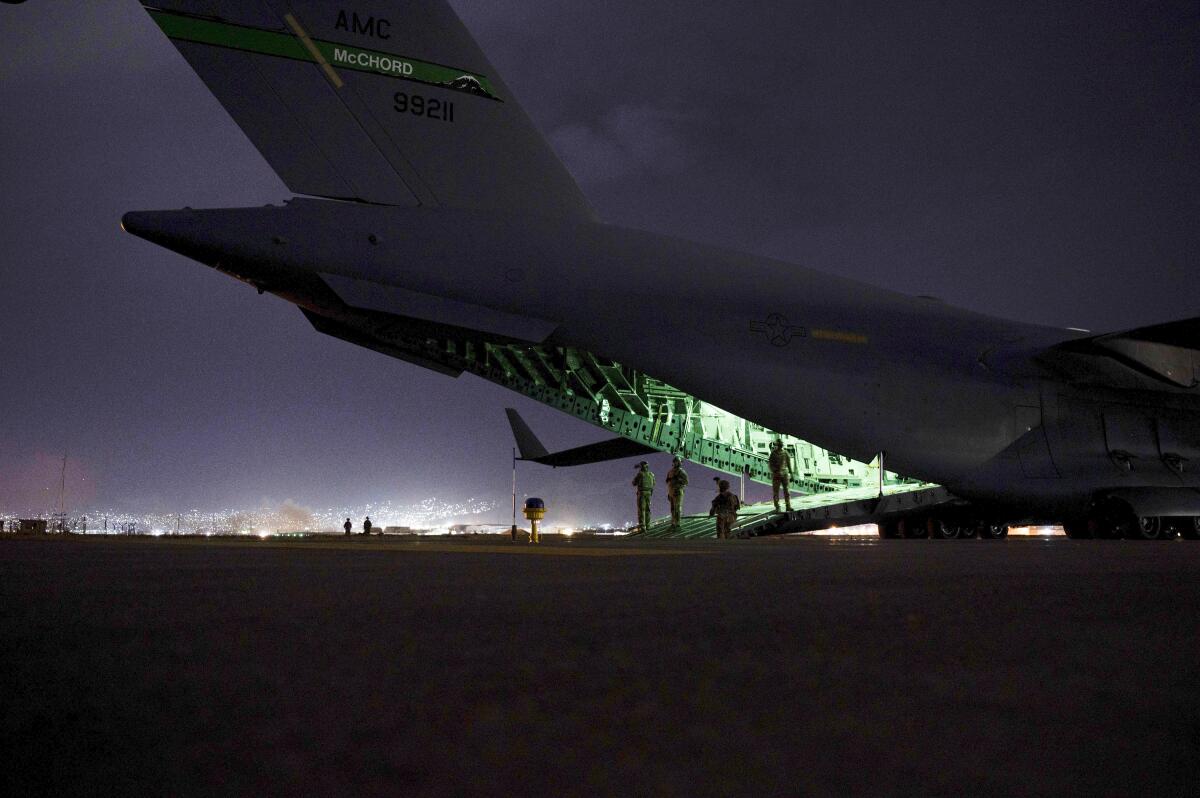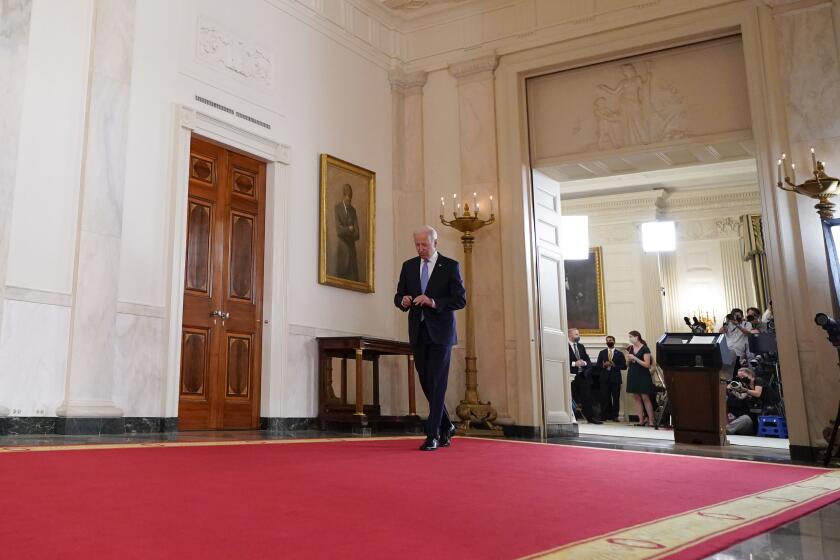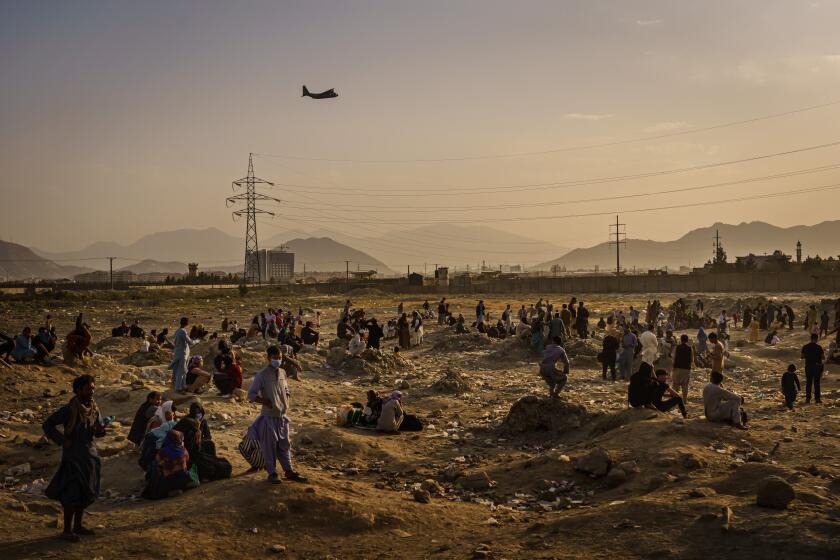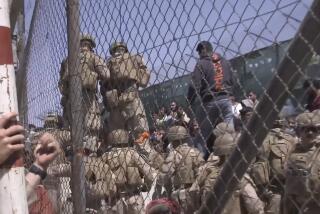‘It just looked apocalyptic’: Crew members describe final flights out of Kabul

- Share via
WASHINGTON — It looked like a zombie apocalypse.
About to make the final U.S. takeoffs out of Afghanistan, U.S. military pilots and air crew saw a sky lit up with fireworks and sporadic gunfire and an airfield littered with the battered shells of planes and destroyed equipment. Stray dogs raced around the tarmac. And Taliban fighters, visible in the darkness through the green-tinged view of night-vision goggles, walked the airfield waving an eerie goodbye.
Lined up on the runway at the Kabul airport Monday night were the five last C-17s to leave the country after a chaotic and deadly airlift that marked the end of America’s involvement in the Afghanistan war. In the final hours, there were no more rocket-defense systems to protect them on the runway, and no one in the airport control center to direct them out.
“It just looked apocalyptic,” said Air Force Lt. Col. Braden Coleman, who was in charge of monitoring the outside of his aircraft for artillery fire and other threats. “It looked like one of those zombie movies where all the airplanes had been destroyed, their doors were open, the wheels were broken. There was a plane that was burned all the way. You could see the cockpit was there, and the whole rest of the plane looked like the skeleton of a fish.”
In interviews Wednesday with the Associated Press, members of the Air Force’s 816th Expeditionary Airlift Squadron who flew out on the last military flights detailed their final fraught hours of what has been a dark, emotional and divisive U.S. exit from a war that now leaves Afghanistan in the hands of the same Taliban enemy it once ousted from power.
“It was just definitely very tense, and we were definitely all on edge watching everything going on to make sure that we were ready,” said Air Force Capt. Kirby Wedan, pilot of MOOSE81, who led the final formation of five aircraft out.
Pentagon officials acknowledge sorrow over Afghanistan and vow to continue the rescue of Americans and Afghan allies left behind in the country.
Adding to the stress, she said, was that their planes were parked in an area of the airport that had been attacked and breached in the past. At one point during the night, a group of civilians got onto the airfield and tried to get to the aircraft, but they were stopped by Army troops securing the plane, said Wedan, who is the squadron’s mission planning cell chief.
Right behind her C-17 was MOOSE92, aboard which Coleman, the director of operations for the squadron, was going through his own checklists for takeoff. When he was told to taxi up a bit farther, he stepped out of the plane to help direct the crew where to go.
“I had my NVGs on, my night-vision goggles, and I had a Raven behind me following me out, making sure that I was, you know, safe,” said Coleman, referring to a member of the specially trained security forces who protect Air Force aircraft. “It was a bit tense — I’m not going to lie. But I guess you don’t really think of it at the time. You just ... do what you’re trained to do.”
For more than three hours, they methodically went through about 300 items on their checklists, packing up the last four Little Bird helicopters, and ensuring they had all their troops and equipment.
President Biden tries to turn the page on a foreign policy crisis with a speech about the withdrawal of U.S. troops from Afghanistan.
From Scott Air Force Base in Illinois, Gen. Jacqueline Van Ovost, commander of Air Mobility Command, watched on video screens as the aircraft lined up for takeoff. One screen showed a scroll of the mIRC chat stream — the online message application that the military uses to communicate. And she could hear the orders from Lt. Col. Alex Pelbath, a pilot who was serving as the mission commander for the final departure.
One by one, each C-17 was told to “clamshell” — close up the ramp. Then Pelbath’s final order: “Flush the force.” With that, Wedan began to move her C-17 down the runway.
“It was definitely different. I’ve never been on an airfield where I didn’t really have permission to take off,” said Wedan, noting the absence of air-traffic control in the tower.
As they lifted off in rapid succession, cheers broke out from the troops on board — most of them special operations forces and soldiers from the 82nd Airborne Division.
As international airlifts from Afghanistan accelerate, the airport backdrop is rife with desperation. Only the lucky are able to flee.
“It was a visible relief,” said Wedan. “You could tell that they had been working really hard. Many of them hadn’t showered in a couple of weeks. They were all incredibly tired. ... You could tell that they were just relieved to be out of there and that their mission was accomplished.”
As the last C-17 cleared Kabul airspace, Pelbath delivered a welcome message: “MAF Safe” — shorthand for saying that the Mobility Air Forces were out of harm’s way.
Maj. Gen. Chris Donahue, commander of the U.S. Army 82nd Airborne Division, had been the last soldier to walk up the ramp on the final C-17 to depart. He had been in charge of security for the evacuation mission. Soon after the aircraft were in the air, he sent his own message: “Job well done. Proud of you all.”
Crammed onto the floor of the aircraft, exhausted troops found places to sleep. “Everyone was kind of sitting on top of each other — whatever we could do to have them get on the aircraft and get them out,” said Wedan.
News Alerts
Get breaking news, investigations, analysis and more signature journalism from the Los Angeles Times in your inbox.
You may occasionally receive promotional content from the Los Angeles Times.
Within 30 minutes, she said, most on her plane were asleep. Coleman agreed.
“I walked downstairs and they warned me not to go to the bathroom because there were too many people in front of the lav door,” said Coleman. “There was one guy who had a box of water bottles that he was using for a pillow. I don’t know how that could have been comfortable. But, hey, he was fast asleep.”
Their flight to Kuwait was about four hours. Coleman said his plane was lucky enough to have extra toilets. Wedan’s had just one — but her crew passed out candy.
“They’re tired and they’re resting now. But I think, for two and a half weeks, you really saw why it was that a lot of us joined,” said Coleman, who enlisted in 2001 after the Sept. 11 attacks that triggered the U.S. invasion into Afghanistan. “To see everybody step up to make this happen in the amount of time that it took to happen, to move 124,000 people out in less than three weeks. I mean, I couldn’t be prouder to be a C-17 pilot today.”
More to Read
Sign up for Essential California
The most important California stories and recommendations in your inbox every morning.
You may occasionally receive promotional content from the Los Angeles Times.













